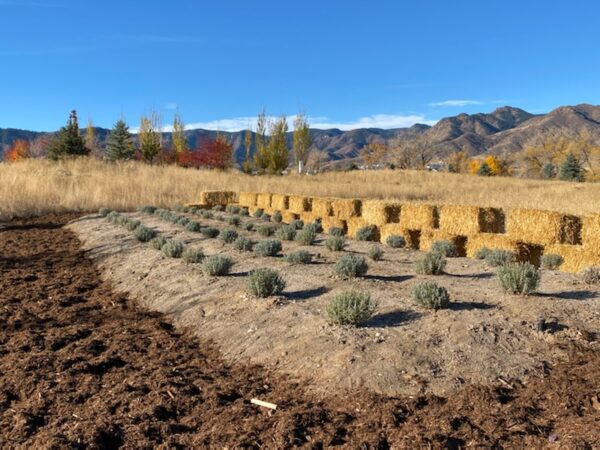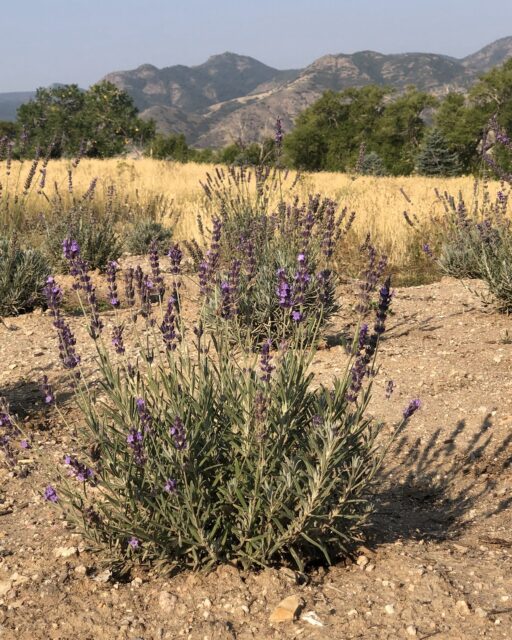
Gardening is a journey…with many beginnings, as well as, endings. There is loss, rebirth, hard work and amazing beauty. There are external challenges and internal satisfaction. There are many people to share the journey with and always those to learn from, too. The journey embarking on the first summer of our lavender garden has been an amazing one.
The journey started as a thought. It began with creating a plot of dirt followed by planting seeds. The seeds had their own journey and I was right along with them. I planted them carefully, prepared a space for them with plenty of heat and water to help them get started and grow through the winter. Watching them develop was fulfilling. Of course, I couldn’t help but picture them in that plot of dirt where they would provide beauty for our visitors at Seven Stones to see. I started out with about 70 seedlings, and ended up with 50 healthy, but still small lavender plants. As they continued to grow, I then bought 70 fuller, older plants to plant in the garden, knowing that the seedlings would not be quite ready. I waited and waited for the weather to warm up, and in early June I carefully rolled the seedlings out to my covered back porch, thinking they would be protected there to start their journey outside. That very same night, a big storm came through, and as the night went on it became a fierce storm with high winds and rain. I kept checking on them, and felt they were holding their own as they were covered. But the next days would bring a sense of disbelief, as I slowly lost about half my plants. It’s a confusing time in the journey when you lose what you have invested so much time in and realize that Mother Nature is always in charge.
Throughout the summer the remaining seedlings never left the limited, but necessary, protection of my covered porch. They got plenty of afternoon sun and were watered twice daily. The 25 seedlings dwindled down to only 11 seedlings, that are just now getting big enough to transplant into their final, bigger container before they can be planted into the ground.
During the growing season, I had the opportunity to go to The Lavender Festival in Palisade. My husband and I visited 5 farms while we were up there. Most of these farmers depend on lavender as a source of income. The beauty of rows and rows of lavender on our beautiful Rocky Mountain hillsides is an amazing sight to see. But they have all had their challenges to get there, too. They constantly struggle with water supply issues, and this last October had a freeze that devastated many of their plants. The tour guides started many of the tours by apologizing for loss of plants and wishing we didn’t have to see incomplete rows. But, it is not what my husband and I saw. The farms were still beautiful and it looked to us as if many more plants survived than did not. The passion for these plants, and the creativity used to introduce lavender as a widely used crop was inspiring. Not many crops can awaken your sense of smell and taste like lavender.
I also have learned so much from each gardener I have talked to that specializes in growing lavender. They all have their different opinions on types of lavender, starting from seed or cuttings, irrigation, fertilization, and harvesting. All this, and then realizing there are over 400 types of lavender! There is so much to learn! I will continue to ask questions and seek out more information on growing and harvesting lavender. I plan to take these expert gardener’s advice and grow from cuttings instead of seed. I will buy from those who have a land full of varied plants to choose from as we grow our Seven Stones Lavender garden. As for my eleven plants…still on the porch…they will most likely end up in my backyard, or you may see a few in our perennial gardens.

I hope that you have had a chance to enjoy the lavender blooms this past summer. The plants that we selected from local sellers have thrived in the well-prepared soil!
Now, it is time to take the next step, as the seasons change, and prepare the plants for winter. The journey leads to a feeling of thankfulness for the growth, an appreciation for what has been lost and also a time of hope for what the next growing season will bring. In my conversations with those lavender specialists, I have learned that winter can be a more fragile season than summer for lavender. They do not like to sit in moisture from snow and cloudy days. They are susceptible to damage in extremely low temperatures. For these reasons, in particular, the plants do so well on the Western Slope because they don’t have a drastic temperature change like the Front Range. When I learned this…I wanted to protect the plants from these winter threats. It was suggested that they be covered. However, with the location they are in, and the heavy winter winds in Roxborough, it did not make sense to put on a “blanket.” So I decided to protect them with a wall of straw bales. This is a more natural approach, and we tend to have many uses for straw around the gardens, so it will not go to waste when the season ends. You will notice the wall has gaps in it. My hope is this will allow for the snow to melt through the gaps. Seasons often bring new journeys. I hope these plants will be comfortable in their winter season of rest, ready to be renewed when the time is right.
Thank you for joining me on this journey. If you have questions, I am always happy to share tidbits of what I’ve learned. Please come find me as you visit, or feel free to email me at alynch@discoversevenstones.com.
